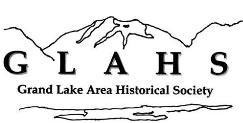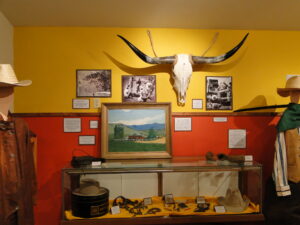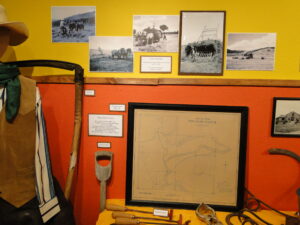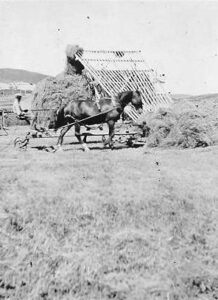Ranches in Grand Lake Area
(A CD is available for $10 with pictures and information about each of the ranches researched for this exhibit. The information and pictures are now available on our web site.)
Click here to see the Guest Ranches of the Valley.
The Ranching Exhibit – “Riding, Roping, and Ranching” was on display at the Kauffman House Museum and Gallery from May – September 2012. It featured a map of the ranches from Rocky Mountain National Park down Highway 34 to Coffee Divide. This map was prepared for the Historical Society by the Grand County cartographer and a copy 17” x 13” is on sale.
In the Gallery was a center display of a timeline from 1870 to the present explaining the history of ranching in the area and showing pictures of many of the ranches and ranch activities.
On the wall of the Gallery was a display with pictures and artifacts loaned by area ranches. It displayed a typical ranching year with Spring roundup and branding, Summer irrigation and haying, Fall rodeo and roundup and Winter feeding. The activities of ranching have not changed much over the years.
Throughout the house were items of clothing associated with ranching and a drawing and poem by a local rancher.
1870
Travel throughout Grand county was by horseback on wagon roads following the early Indian and game trails. The ranches in the area provided a resting place for horses, a place to stay and food to eat for those who were living in and visiting the area.
Berthoud Pass Stage Road, built by Captain Gaskill with stupendous effort, came from the top of the pass down through Spruce Lodge, Idlewild (now Winter Park), the Cozens Ranch near Fraser, Junction Ranch at Tabernash and Coulter. From Coulter one branch led over Cottonwood Divide to Hot Sulphur Springs and points West, the other went to Selak’s and over Coffey Divide to the Lehman Post Office and on to Grand Lake and the Kauffman House Hotel.
The settlers, although occupied with Indian troubles during the 70s, had developed industries and community life necessary for permanent settlement. Ranchmen were putting up large quantities of hay and some developed a business wintering horses from Georgetown and Empire. C. H. Hook took a large flock of sheep over Rollins Pass in 1873
The natural meadows were ideal for buffalo and elk and now were an ideal place for cattle and sheep. This mountain park, carpeted with timothy and grass, with an adequate water supply, furnished excellent protection for stock during the storms in winter and against the heat in summer.
The higher, more inaccessible ranges of the area are excellent for sheep. Stock and sheep raising conditions were ideal and but for the inadequate and distant market, would have been highly profitable. To drive the cattle out was not profitable, because the animals lost too much weight in such a long drive. The cost of hay for ranchers moving animals was high and there was a toll to be paid for loose stock on roads, bridges and passes. The fee on the Middle Park and South Boulder Wagon road was five cents per head, and the same fee was charged for going over Rollins Pass. These tolls do not seem great, but together with the loss of weight the cattle experienced, it made the stockman look forward to the coming of the railroad.
In Grand County in 1878 the value of land was $11,100. There were 548 horses, 10 mules, 835 cattle, 700 sheep and 11 swine.
1880
By the 1880s the expansion of the cattle industry resulted in the need for additional open range. Then many ranchers expanded into the northwest where there were still large tracts of unsettled grassland. In the 1880s the land for open range was unregulated and overgrazing occurred. Drought caused the death of many animals.
Fencing helped to rotate pastures. Barbed wire was an innovation of the 1880s which allowed cattle to be confined to a designated area to prevent overgrazing of the range.
Ranchers that were here supplied meat to the miners in the area and also provided meat to the markets in Denver.
The first brand registered in Colorado was the Bar over SS in 1884 by John Sheriff’s great grandmother who filed on her homestead near Hot Sulphur Springs.
Brands are registered at the county seats. It now costs $225 to register your brand for five years. There are 32,609 registered brands in Colorado.
1890s
The chief industry in Grand County was stock raising. The hay crop was estimated in 1893 to be 12,000 tons and 9,000 pounds of wood were raised. The population of the county dropped to seven hundred.
1900s
National forests were established in 1900 – three fourths of all national forests in this Grand County were used for pasturage for cattle and sheep in the summer. The regulation of this area helped to establish the livestock industry and prevent sheep and cattlemen’s war and over-grazing. These regulations stimulated many cattlemen to settle in Middle Park.
There was renewed hope for a railroad – David Moffat visualized and brought about this gigantic undertaking before his death. It was first to be an electric line and then was changed to steam – the Denver, Northwestern and Pacific Railroad.
The arrival of the train as far as Hot Sulphur Springs in 1906 provided a way for the ranchers to send their animals to market.
1910s
Rocky Mountain National Park was established in 1915. The opening of the Fall River Road and later Trail Ridge Road brought many changes to the valley.
The coming of the automobile and better roads opened Grand County to tourists.
1920s
Fall River Road opened in 1920 through the park. This enabled people to travel a circle route from Denver to Estes Park, through the new Rocky Mountain National Park, Grand Lake, Georgetown and Idaho Springs and back to Denver – this was at least a three day trip.
Tourists needed places to stay and the ranchers began catering to the tourists which gave them additional income.
The Dude Ranch – Guest Ranch provided entertainment for many years from 1920 to the 1960s.
1930s
Trail Ridge Road through Rocky Mountain National Park opened in 1932. An improved road increased the numbers of people who visited the park and the Grand Lake area.
Taylor Grazing Act of 1934 – named for Representative Edward Taylor of Colorado – assigned an exclusive number of animal unit months based on the land’s carrying capacity. Colorado has 598,980 animal unit months on 2,600,000 acres.
In Grand County the open range is controlled by three ranger districts, two national forests, the Bureau of Land Management, two water conservancy districts and miscellaneous state land. The number of animal unit months are controlled and assigned by the ecological condition of a given area as well as the weather. Each year is different.
In 1937 in Grand County the value of the land was $1,147.200. There were 2,000 horses, 24 mules, 18,127 cattle, 2,442 dairy animals, 15,660 sheep and 99 swine.
1940s
In the 40s and 50s the ranches south of Grand Lake were acquired by the government for the Colorado Big Thompson wager project, building water reservoirs – Shadow Mountain and Granby – to provide water for the people of the front range for agriculture. Today most of this water is used for the people who have moved to the front range from Fort Collins to Boulder.
1950s
Guest Ranches or Dude Ranches reached their peak in popularity in the 1950s. Vacations in the mountains gave people the opportunity to escape the heat of the cities before air conditioning was prevalent. The opportunity to enjoy the outdoors, go hiking and riding, was the ideal vacation. All day trail rides, campfires, rodeos, and square dancing were activities the whole family could enjoy.
1960s
As the tourists changed their interest from rustic cabins to hotels, ranchers had little interest in modernizing and little money to upgrade. The National Park Service began acquiring land adjacent to Rocky Mountain National Park to prevent the commcial development of the land and to protect the wilderness. As ranchers retired, the park purchased the land, returned it to nature, and many ranches became part of the national park.
1970s to today
A few guest ranches remain in the Grand Lake area. West of Highway 34 are ranches that are still operating. Some have been divided into smaller parcels for development.










